The next stop, after leaving Merida on Isla de Ometepe, was Masaya, Nicaragua. The main draw was the Masaya Volcano, though visiting the town of Masaya, and specifically the market, was first on the agenda.
The house rental was in a peaceful spot beyond the outskirts of Masaya, a short walk from the main highway between Managua and Masaya. We could catch a bus to get into town. Buses in Nicaragua (and, in Central America, in general) are not what we are used to in the United States. They are all independently run businesses. Riding one is an essential Central American experience.
We got out to the highway and walked to the bus stop. Shortly a brightly painted, old school bus pulled up with someone leaning out the door shouting out the bus's route and destinations. We confirmed that the bus would pass through Masaya and got on and found seats. The buses are operated by two people: the driver and what one might call the money man. This second person is the one leaning out the open door as the bus pulls to a stop shouting out the route info and basically soliciting passengers to get on; he helps people board and is the one who collects the fares. A common amount was 20–40 córdobas per person (approximately $1–2 US). Though the bus will stop at the frequent bus stops, if there are people collected on a corner anywhere else along the road, the bus will slow down, and the money man will open the door and shout out the route.
These buses are “never” too full. One bus ride was in an 18-passenger small school bus that looked full when they stopped to pick us up; they loaded us on, anyway. One of us had to stand, because all seats were taken, and stood bent over because there wasn't enough headroom to stand up. Then four more people were squeezed into the bus, all standing. Personal space shrinks. Then three more people. At one point, the money man paid a couple people to get off so he could cram a threesome on, who were going further—more fare money. (I assume he knew they were getting off anyway, soon, but didn't want to miss the chance to get the waiting people on)—so there IS a limit to how many people…. The more people on the bus, the more money the business can make. So the the buses are never too full.
A positive of this laissez-faire business opportunity is that, though there are few fixed schedules, there are frequent buses.
There are a lot of taxis, too. As gringos walking around, we were frequently asked by a driver if we needed a ride.
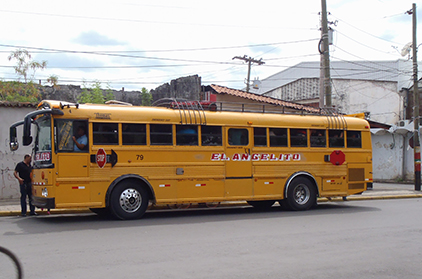
An old school bus that is now an independent bus business, still sporting its school bus colors.
The Market at Masaya is amazing. There are a couple acres of makeshift stands outside selling produce, canopies rigged to get out of the intense tropical sun. The open dirt area also contains a separate area which is the main bus “terminal,” where buses to Masaya arrive and depart.
In addition to the open-air part of the market, there is a covered area, a sprawling building that is maze-like and feels huge, easy to get lost in. If you have ever been to Seattle’s Pike Place Market, there are similarities—the numerous vendors of all sorts, the crowds—but imagine the aisles are maybe just four or five feet wide between rows of shop spaces on either side.
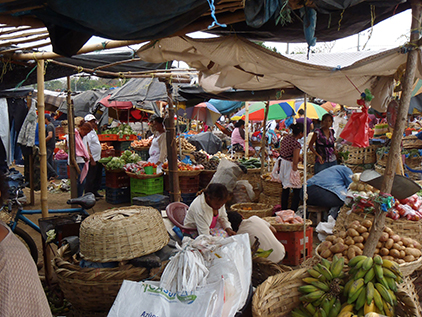
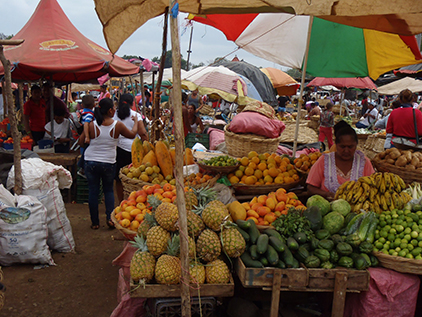
The outdoor produce market covered a couple acres.
The shop spaces are 10–15 feet wide and some are as deep, with shelves and displays as high as one can reach, selling everything imaginable—from all types of food products (rice, beans, meats, fish), to clothing, household goods, hammocks, arts and crafts, and services such shoe repair, haircuts, and beauty salons.
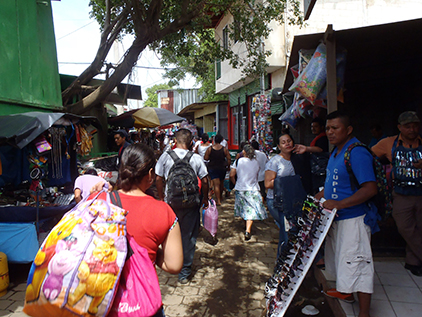
A street full of vendors outside the main indoor market.
The various shops are organized by categories, so that all the shoe shops are near each other, for example. That way, if you are looking for something specific, you can find most of the shops selling it in one area. Outside the covered market space, the sidewalks are filled with more vendors who do not have space inside.
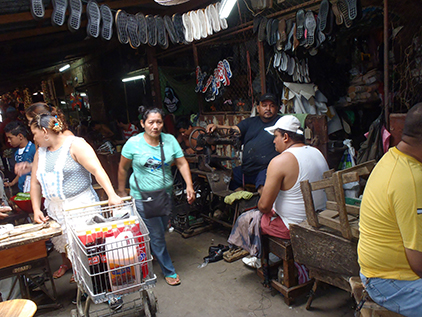
Shoppers inside the crowded market.
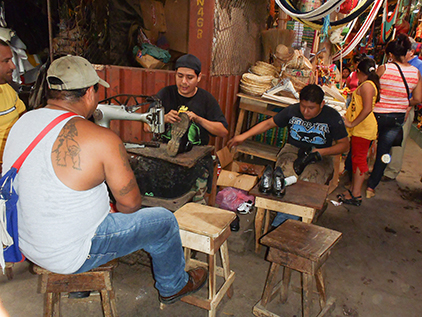
Shoe repair.
Crowds of people inside and out fill the air with a glorious cacophony of voices, seller cry-outs, and music blaring from shops stalls. This is called the “new” market. The “old” market has been turned into more of a gringo tourist shopping area. All day, the only gringos we saw in the “new” market were us.
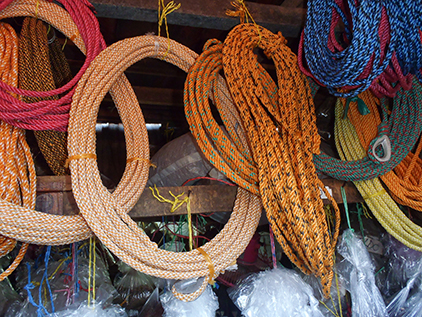
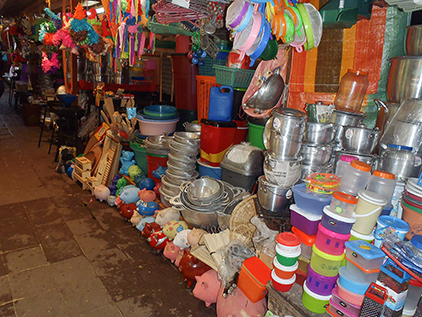
Walking through the indoor market, you can hear the changing sound landscape.
Masaya and Granada both have horse carriages for tourists, a two-horsepower taxi service.
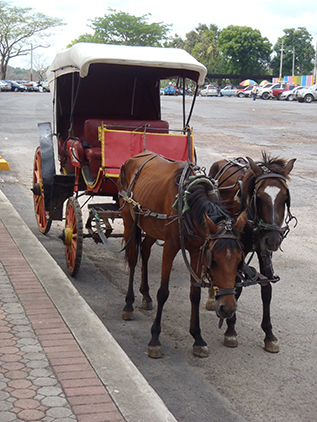
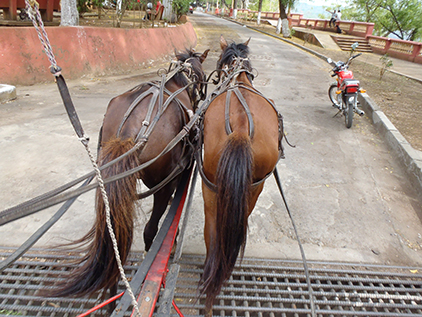
Horse-drawn carriage in the traffic on Masaya streets—a tourist ride that has more character than a taxi.
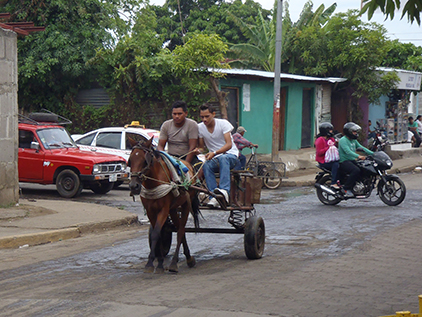
Nicaragua, being a relatively poor country, has many horse-drawn carts.
The town of Masaya shares its name with the volcano. Wikipedia has great information about the Masaya Volcano, which I won’t repeat here. Suffice it to say the volcano is still active, though not currently producing lava flows or throwing out rocks. The activity is in the form of sulfurous fumes that can fill the crater and billow out—as it was doing on the day we visited.
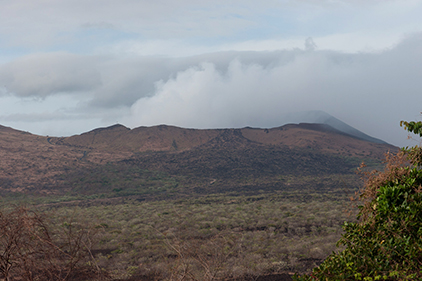
The view of the distant Masaya volcano from the rental house.
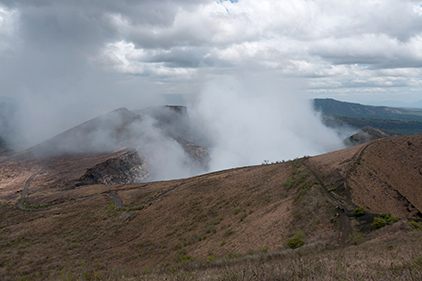
The cloud of fumes rising out of the active crater.
Visiting comes with a caution. When you park in the parking area at rim of the active crater one must park facing OUT for a quick getaway, should conditions suddenly change.
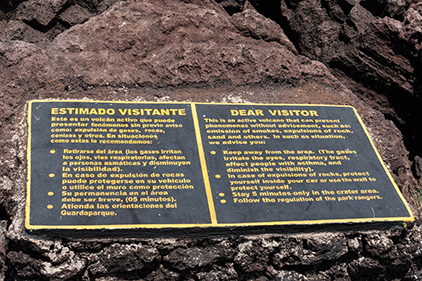
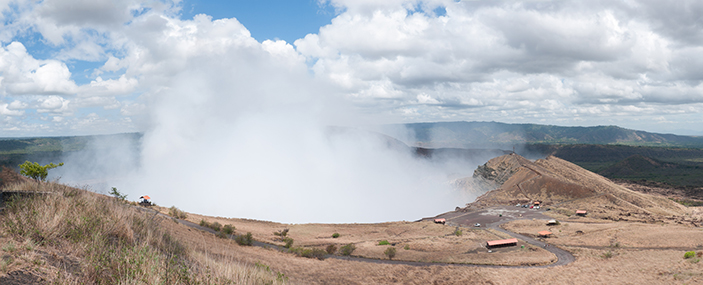
A panoramic photo of the active crater at Masaya volcano.
A time-lapse video of the fumes boiling out of the crater. This 13-second video spans 5½ minutes of real time.
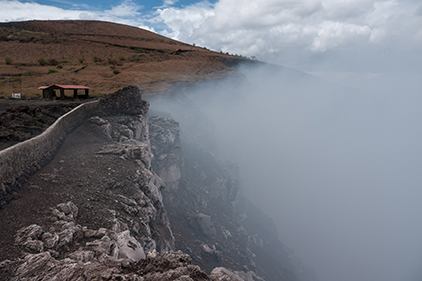
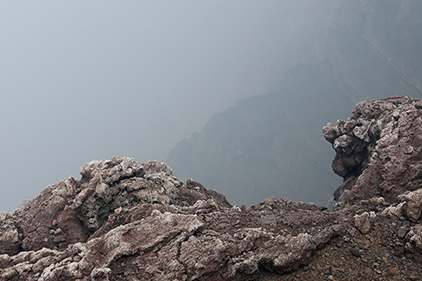
Dense, sulfurous fumes at the edge of the volcano crater.
That evening, out in the courtyard of the rental house, where I was sitting enjoying the slight cooling of the evening (it had been another 95°F day), there were cicadas on either side of me, in the two trees and broadleaf vines clinging to the trees. The sound was amazingly intense. To appreciate what I was hearing, listen through headphones. Turning your head does not change what you hear. That is what I experienced sitting outside. I could not discern the location of the sound source by turning my head. It sounded like it came from everywhere, wrapping around and getting inside my head.
Listen through headphones to experience the surround-sound intensity of the cicadas.